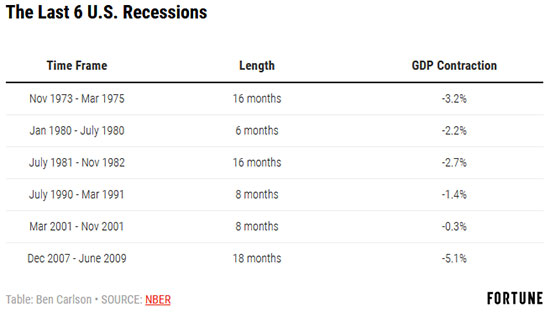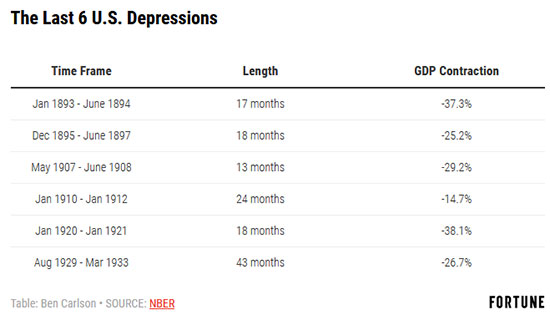衰退和蕭條有何區(qū)別,?讓歷史告訴我們
|
今天我們對整體“經(jīng)濟”的認(rèn)知仍是一個較新鮮的事物。實際上,,作為衡量經(jīng)濟增速的現(xiàn)代概念,國民生產(chǎn)總值(GDP)一直到大蕭條之后才出現(xiàn),。 經(jīng)濟學(xué)家西蒙·庫茲涅茨因在這個領(lǐng)域中的研究而獲得了諾貝爾獎,。1934年,,庫茲涅茨在向美國國會提交的報告中用國民收入這個概念來追蹤經(jīng)濟活動。GDP就是由這個概念蛻變而來,,但直到二戰(zhàn)結(jié)束前,,它還不是世界各國采用的標(biāo)準(zhǔn)方法。 只要可以衡量經(jīng)濟產(chǎn)出,,經(jīng)濟學(xué)家就有可能回過頭去計算此前的滑坡給經(jīng)濟帶來的損害,。 19世紀(jì)出現(xiàn)過18次經(jīng)濟衰退,6次恐慌,,或者說蕭條,。美國國家經(jīng)濟研究局有紀(jì)錄的時間最長的GDP收縮期為65個月,從1873年10月到1879年3月,,這被稱為“長期蕭條”,。與之相比,1929-1932年的大蕭條持續(xù)了43個月,。 19世紀(jì)初土地價格由盛轉(zhuǎn)衰后,,恐慌進(jìn)入了經(jīng)濟詞典,指的是造成巨大崩潰的投機性經(jīng)濟階段,。在整個19世紀(jì),,人們一直用‘恐慌’來描述如今被稱為蕭條的情景。政府官員覺得他們需要一些不那么讓公眾警覺的詞匯,,就這樣,,衰退和蕭條開始成為不同程度的經(jīng)濟滑坡的代名詞。 衰退vs.蕭條 衰退和蕭條的差別并無標(biāo)準(zhǔn)定義,,但蕭條一般指經(jīng)濟收縮的幅度較大,,而且時間較長。如果用以往的六次衰退和六次蕭條進(jìn)行比較,,二者區(qū)別一目了然,。以下是美國曾經(jīng)出現(xiàn)的六次衰退: |
The whole idea of "the economy" as we know it today is still a relatively new phenomenon. In fact, the modern concept of gross domestic product (GDP) as a way to measure economic growth wasn't developed until the aftermath of the Great Depression. Simon Kuznets, an economist who won the Nobel Prize for his work in this area, put forth a report to Congress in 1934 using a concept called national income to track economic activity. GDP was bourne out of this idea but it wasn't the standard method used by countries around the globe until the end of WWII. Once economists were able to measure economic output they could go back to calculate the damage previous downturns had on the economy. In the 1800s there were 18 recessions in addition to 6 panics or depressions. The National Bureau of Economic Research (NBER) lists the longest GDP contraction on record as 65 months in length which was from October 1873 to March 1879 in what is known as the Long Depression. In comparison, the Great Depression of 1929-1932 was 43 months long. After a land price boom-bust in the early 1800s, the word panic entered the lexicon and was used to describe speculative economic episodes that resulted in a spectacular collapse. The term ‘panic’ was used for the remainder of the century to describe what is now termed a depression. Government officials decided they needed something that was less alarming to the public which is how the terms recession and depression came to be used to describe economic downturns of varying severity. Recession vs. Depression There is no standard definition of the difference between a recession and a depression but depressions are typically more severe in terms of the magnitude and length of the economic contraction. If we compare the past six recessions with the past six depressions, the distinction becomes clear. Here are the past six U.S. recessions: |

|
而這是以往美國的六次蕭條(其中一些在當(dāng)時被稱為恐慌): |
And the past six U.S. depressions (some of which were called panics at the time): |

|
衰退會持續(xù)多長時間? 此前的六次衰退中,,GDP平均降幅為2.5%,,持續(xù)時間平均為12個月。而以往六次蕭條的GDP平均降幅為28.5%,,平均持續(xù)時間為22個月,。值得注意的是,其中多次蕭條,,或者說恐慌出現(xiàn)之際,,美國或多或少還是一個新興市場。在19世紀(jì)和20世紀(jì)早期,經(jīng)濟活動差不多和股市一樣起伏不定,。相比之前,,現(xiàn)在經(jīng)濟要成熟得多,但股市仍表現(xiàn)出與之類似的波動性,。 如今,,專家和職業(yè)投資人都在將目前的經(jīng)濟狀況和1929年秋天,也就是大蕭條即將到來時的經(jīng)濟形勢相比,。任何用大蕭條來進(jìn)行類比的人對歷史的理解都不夠深刻,。即使是2007-2009年的嚴(yán)重金融危機也無法和二戰(zhàn)前的那些經(jīng)濟滑坡相提并論,而且那場危機不知因何并未演化成全面衰退,。 然而,,一些較小的國家依然能感受到恐慌,或者說蕭條的痛楚,。比如說,,2008-2013年希臘GDP下跌了26%,失業(yè)率飆升至近30%,。這兩個數(shù)字都比美國的大蕭條更為嚴(yán)重,。 對大多數(shù)個人的經(jīng)濟處境來說,這些經(jīng)濟定義可能不那么重要,。小幅衰退對某些人來說可能像是一個機會,,但對其他人而言則是一次蕭條。這完全取決于人們的工作,、家庭以及財務(wù)狀況,。 美國的“經(jīng)濟”價值超過20萬億美元。我們對這臺巨型機器的認(rèn)知往往被個人感受所左右,,在經(jīng)濟擴張和收縮時都是如此,。 對于經(jīng)濟來說,沒有什么是不可能的,,因為我們對未來局勢一無所知,,但我們可以指出的一個事實是,現(xiàn)在美國經(jīng)濟比過去要穩(wěn)定得多,。(財富中文網(wǎng)) 本·卡爾森是特許金融分析師,,在Ritholtz Wealth Management擔(dān)任機構(gòu)資產(chǎn)管理業(yè)務(wù)主管。 譯者:Charlie 審校:夏林 |
How long do recessions last? The average GDP contraction over the past six recessions was -2.5%, lasting 12 months on average. The average GDP contraction over the past six depressions was -28.5%, lasting 22 months on average. It is worth noting that the United States was more or less an emerging market when many of these depressions and panics occurred. Economic activity was nearly as volatile as the stock market during the 19th century and early part of the 20th century. The economy is far more mature now while the stock market still exhibits similar levels of volatility. There are pundits and professional investors alike these days who evoke comparisons between today's economy and what began in the fall of 1929 prior to the onset of the Great Depression. Anyone making Great Depression analogies hasn't read enough history books. Even the Great Financial Crisis of 2007-2009, which somehow didn't morph into an all-out depression, looks tame when compared to economic downturns in the pre-WWII era. There are, however, smaller countries that can find themselves in the throes of a panic or depression. Greece, for instance, saw GDP decline 26% from 2008-2013 and unemployment spike to nearly 30%. Both of these figures were worse than what the U.S. experienced during the Great Depression. For most individuals, these economic definitions likely don't matter all that much for their personal situation. A shallow recession can feel like an opportunity for some but a depression for others. It all depends on the context in terms of your job, family, and financial situation. "The economy" in the United States is worth more than $20 trillion. Our feelings about this massive machine are often swayed by our own personal experiences with it, which is true of both economic expansions and downturns. Nothing is impossible when it comes to the economy because we have no idea what the future holds but we can say for a fact that the U.S. economy is much more stable now than it was in the past. Ben Carlson, CFA is the Director of Institutional Asset Management at Ritholtz Wealth Management. |













